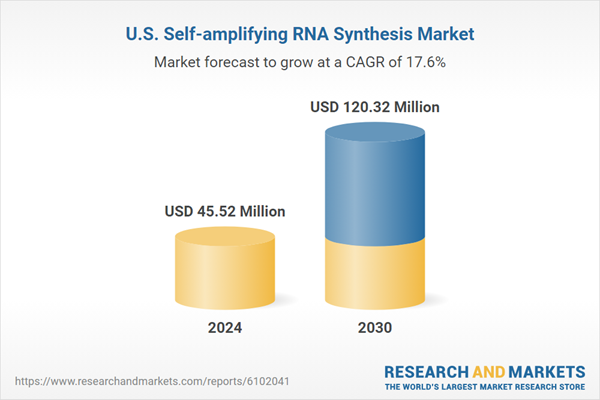Speak directly to the analyst to clarify any post sales queries you may have.
10% Free customizationThis report comes with 10% free customization, enabling you to add data that meets your specific business needs.
The evolution of delivery technologies, such as lipid nanoparticles (LNPs) and novel encapsulation methods, has further accelerated adoption by improving cellular uptake and controlled release. Growing government support, regulatory advancements, and increased interest in RNA platforms beyond infectious disease vaccines are collectively driving market momentum in the U.S. research and biotech sectors.
Key Market Drivers
Surging Demand for Next-Generation RNA Therapeutics and Vaccines
The increasing demand for next-generation RNA-based treatments and vaccines is a primary driver of the United States Self-amplifying RNA Synthesis Market. saRNA offers strong protein expression at low doses, enabling more efficient and cost-effective therapies. Its ability to self-replicate inside host cells makes it a compelling platform for therapeutic development in areas like infectious diseases, cancer, and rare genetic disorders.This demand is further supported by the rising burden of genetic conditions in the U.S., with the CDC reporting approximately 25 million Americans affected by rare diseases, most of which are genetic in nature. saRNA presents an innovative approach to addressing these unmet medical needs by offering high therapeutic potency, scalable production, and more manageable dosing regimens - particularly important for sensitive patient groups such as children and the immunocompromised.
Key Market Challenges
Lack of Standardization in Synthesis Protocols
A critical barrier to market growth is the absence of standardized protocols for synthesizing self-amplifying RNA. Unlike conventional mRNA, saRNA molecules are larger and more complex, necessitating precise control over transcription, capping, and purification steps. The use of proprietary methods by different laboratories leads to inconsistency in product quality, reproducibility, and scalability, hindering broader clinical and commercial adoption.This variability poses significant challenges for regulatory review, as agencies lack universal benchmarks for evaluating saRNA-based products. As a result, time-to-market may be prolonged due to inconsistent documentation and analytical outcomes. Smaller firms face added difficulty in aligning with regulatory expectations, often relying on costly and time-consuming trial-and-error approaches. The lack of harmonized synthesis and quality control standards also complicates technology transfer and batch consistency in manufacturing, which limits efficient scaling and commercialization.
Key Market Trends
Modular and Plug-and-Play Platform Development
An emerging trend in the United States Self-amplifying RNA Synthesis Market is the development of modular and plug-and-play platforms that streamline saRNA design, customization, and production. These platforms allow interchangeable use of standardized components - such as replicase sequences, UTRs, capping strategies, and antigen modules - without requiring full redesigns, enabling faster adaptation to new disease targets or emerging variants.Such modular systems support rapid prototyping and reduce development timelines, making them ideal for evolving indications in oncology, infectious diseases, and autoimmune conditions. Integration with delivery mechanisms like LNPs and viral vectors ensures cross-compatibility and simplifies regulatory workflows. Additionally, these platforms enhance reproducibility and facilitate scaling from research batches to GMP-grade manufacturing, making them vital for organizations pursuing diverse RNA therapeutic pipelines.
Key Market Players
- GenScript Biotech Corporation
- Creative Biogene, Inc.
- OZ Biosciences SAS
- BOC Sciences
- Croyez Bioscience Co., Ltd.
- Creative Biolabs, Inc.
- Maravai LifeSciences Holdings, Inc.
- Areterna LLC
- Applied DNA Sciences, Inc.
- Moderna, Inc.
Report Scope:
In this report, the United States Self-amplifying RNA Synthesis Market has been segmented into the following categories, in addition to the industry trends which have also been detailed below:United States Self-amplifying RNA Synthesis Market, By Product & Service:
- Products
- Premade saRNA
- Enzymes & Reagents
- Others
- Custom Synthesis Services
United States Self-amplifying RNA Synthesis Market, By Application:
- Therapeutics Development
- Infectious Diseases
- Oncology
- Others
- Biomedical Research
United States Self-amplifying RNA Synthesis Market, By End User:
- Pharmaceutical & Biotechnology Companies
- Academic & Research Institutes
- Others
United States Self-amplifying RNA Synthesis Market, By Region:
- North-East
- Mid-West
- West
- South
Competitive Landscape
Company Profiles: Detailed analysis of the major companies present in the United States Self-amplifying RNA Synthesis Market.Available Customizations:
With the given market data, the publisher offers customizations according to a company's specific needs. The following customization options are available for the report.Company Information
- Detailed analysis and profiling of additional market players (up to five).
This product will be delivered within 1-3 business days.
Table of Contents
Companies Mentioned
- GenScript Biotech Corporation
- Creative Biogene, Inc.
- OZ Biosciences SAS
- BOC Sciences
- Croyez Bioscience Co., Ltd.
- Creative Biolabs, Inc.
- Maravai LifeSciences Holdings, Inc.
- Areterna LLC
- Applied DNA Sciences, Inc.
- Moderna, Inc.
Table Information
| Report Attribute | Details |
|---|---|
| No. of Pages | 85 |
| Published | June 2025 |
| Forecast Period | 2024 - 2030 |
| Estimated Market Value ( USD | $ 45.52 Million |
| Forecasted Market Value ( USD | $ 120.32 Million |
| Compound Annual Growth Rate | 17.5% |
| Regions Covered | United States |
| No. of Companies Mentioned | 10 |









